Crown SASS-P MK II Application Manual
- Category
- Soundbar speakers
- Type
- Application Manual

128137-1
6/00
PZM, PCC, SASS, GLM, LM, and CM
Crown International, Inc
P.O. Box 1000, Elkhart, Indiana 46515-1000
(219) 294-8200 Fax (219) 294-8329
www.crownaudio.com
© 2000 Crown International, All rights reserved.
PZM
®
, PCC
®
, SASS
®
,
are registered trademarks of Crown International,
Inc. Also exported as Amcron
®

2
MICROPHONE TECHNIQUES FOR HOUSES
OF WORSHIP
In your house of worship, wouldn’t you like to bet-
ter understand what is being said, and hear music
reproduced with a full, natural sound? You can do
this with a good sound system.
One goal of the sound system is to help the con-
gregation hear more clearly. The message is im-
portant, so it must be loud enough and easy to
understand. Another goal is to reproduce music
with high fidelity or naturalness.
To help you meet these goals, this guide offers
some tips on microphone techniques. The types
of microphones you choose—and their place-
ment—have a major effect on the sound quality.
MICROPHONE TYPES
Microphones (or “mics” for short) are available in
many types.
• Miniature clip-on mics (lavalier mics), which
you clip onto the minister’s robe or onto musi-
cal instruments.
• Lectern mics, which you mount on the pulpit or
lectern.
•
Surface-mounted mics which you put on sur-
faces (floor, ceiling, walls, tables).
• Miniature choir mic
s
which you hang over the
choir.
• Handheld mics for vocalists and instruments.
Crown makes a microphone for each of these
needs. Many of the mics are so small, they become
nearly invisible in use. In this way, the microphones
do not distract from the service.
Microphones can also be classified according to
the way they pick up sounds from different direc-
tions. An
omnidirectional (omni) mic picks up
sound equally well from all around. A
unidirectional
mic picks up mainly what it’s aimed at. The most
common type of unidirectional mic is the
cardioid
type. Unidirectional mics help prevent feedback.
Feedback is the squealing sound you hear when the
sound system is turned up too loud. The amplified
sound from the loudspeakers enters the micro-
phones and is reamplified.
Microphones also differ in the way they convert
sound to electricity. A condenser
or
electret con-
denser microphone is charged with static electric-
ity inside; a dynamic or moving coil microphone
has a magnet and a coil of wire. Generally, the con-
denser type is higher quality, but requires a power
supply to operate, such as an internal battery or an
external phantom power supply. This supply is al-
ready built into some mixers. Another advantage of
the condenser type is that it can be miniaturized.
A miniature condenser mic is desired when you want
the mic to be invisible—say, hanging over the choir,
clipped onto the minister’s robe, or affixed to the
pulpit.
HOW TO REDUCE FEEDBACK
First, here are some general tips on microphone us-
age to reduce the likelihood of feedback.
• Use as few microphones as possible.
• Keep loudspeakers and microphones as far apart
as is practical.
• Turn down microphones not in use.
• Keep microphones close to their sound sources
— as close as possible, but no closer than nec-
essary to achieve adequate volume before feed-
back occurs.
• Use directional microphones. A microphone is
directional if its polar pattern is cardioid,
supercardioid, or hypercardioid (check the mi-
crophone data sheet).

3
SPECIFIC MIC TECHNIQUES
Below are some suggested microphone techniques
for each sound source.
Minister
The type of mic you will use on the minister de-
pends on whether the minister stays at the pulpit or
moves about.
If the minister stays at the pulpit, install a lectern
mic on the pulpit (
Fig.1
). Another purpose for a lec-
tern mic is to pick up anyone who walks up to the
lectern to make an announcement or read a pas-
sage.
Crown makes three microphones for this purpose:
the LM-201, LM-300A, and LM-301A. The LM-201
(see page 8) has a shock-mounted mic capsule and
a ball-and-socket swivel mount that adjusts silently.
The LM-300A (see page 8) is a slim gooseneck
model that also adjusts silently. It plugs directly into
a connector on the pulpit. The LM-301A adapts to a
5/8"-27 threaded adapter, and its cable can exit
downward or out the side.
Fig. 1—Miking the minister with a lectern mic on
the pulpit.
One microphone at the pulpit gives a more consistent
tone quality than two, so install only one. Be sure to
add the provided foam
pop filter (windscreen)
to pre-
vent explosive breath sounds (pops). Another way
to reduce pops is to speak about 8 inches from the
microphone and over the microphone rather than
into it.
If you don’t want to install the pulpit mic perma-
nently, try mounting a handheld mic (
CM-200A or
CM-700—Fig. 2
) on a boom stand about 8 inches
away from the minister’s mouth. Put a foam pop
filter (windscreen) on the microphone.
Fig. 2—Pulpit miking with a CM-200A.
Yet another alternative is to place a unidirectional
boundary mic (such as the Crown (PCC
®
-130, PCC-
160, PCC-170)
on top of the pulpit, near the edge
furthest from the person speaking
(Fig. 3)
.

4
Fig. 3—Pulpit miking with a PCC-160.
If the minister moves about, use a clip-on lavalier
microphone (
Fig. 4)
, either with a mic cable or with
a wireless transmitter worn on the belt. The trans-
mitter comes with a receiver, which you plug into a
mic input in your mixer. Attach the mic at chest
height. Use the belt clip that came with the micro-
phone, or place the mic connector in the pocket to
act as a cable strain relief.
Fig. 4— Miking the minister with a clip-on micro-
phone.
A wireless lavalier microphone also works well for
a storyteller on the steps of the platform. Install a
fresh battery in the transmitter before each service,
and tell the minister or lay person to turn on the
transmitter before speaking.
Choir
If your choir is loud enough in your church without
amplification, you don’t need to mike the choir un-
less you want to pick them up for recording or
broadcast.
For permanent installations, you can hang minia-
ture mics over the choir. The Crown
CM-30
or
CM-
31
microphone (see page 8) are especially designed
for choir miking; they are almost invisible in use
and sound natural. Use one microphone in the cen-
ter of every 20-30 foot span. A choir of 30 to 45
voices should need only two or three mics.
If the choir mics are used for sound reinforcement,
place them close to the choir to minimize feedback:
about 1½ feet in front of the front row of singers,
and about 1½ feet above the head height of the back
row (
Fig. 9
). If the mics are used only for recording
or broadcast, you can place them a few feet farther
to pick up the acoustics of your santuary.
Fig. 5—Choir miking
.

5
Fig. 6—A stand-mounted handheld microphone
.
Fig. 7— Three singers using one microphone.
If you don’t want to hang the mics, attach them to
stands using the CM-30SA stand adapter. Make the
mic stands tall by adding baby booms.
Soloist or Reader
This person can be covered with a stand-mounted
handheld microphone such as the Crown
CM-200A
(Fig. 6
). The handheld mic will come with a mic
holder (swivel mount or clip) which screws onto
the mic stand. Be sure to place the foam pop filter
(windscreen) on the mic to prevent breath pops.
Use a baby boom on the mic stand to reach a per-
son seated in a presider’s chair.
A vocalist might prefer a wireless mic in order to
move freely on stage. This is a microphone with a
radio transmitter built into the handle. Wireless mics
are susceptible to interference from lighting dim-
mers, fluorescent lights and auto ignitions, but this
interference is minimal if you use a VHF high-band
or UHF system. Good wireless mics cost $1000 and
up, so try the mic in your house of worship before
buying.
Vocal Duo or Trio
As shown in
Fig. 7,
place one CM-200A handheld
mic on a stand 1 to 2 feet in front of the center of
the group.
Predue
(Kneeling Bench for Weddings)
Try a
PCC-160
unidirectional boundary microphone
on the floor near the bench.
Altar Table
Place a
PCC-130, PCC-160, PCC-170
, unidirectional
boundary mic on the table aiming at the people
speaking. The first three models listed above are
available in white to blend with a white tablecloth.
Baptismal
Hang a miniature choir mic (
CM-30 or CM-31
) over-
head, or mount a
PZM
®
-6D
inside on the glass
(Fig.
8
). If the baptismal is shallow, you can use a wire-
less lavalier mic
because it eliminates the electrical

6
Fig. 9—Wedding pickup.
Fig. 10—Stage miking with PCCs.
hazard of dropping a microphone into the water.
The wireless mic uses only a 9-volt battery and
poses no risk of shock.
Wedding
As shown in
Fig. 9,
try one lavalier mic on the min-
ister. It will pick up the minister, bride and groom.
Fig. 8—Baptismal pickup.
Organ
You won’t need to mic the organ for sound rein-
forcement, but you might need to for recording or
broadcast. Crown
GLM-100
or
CM-150
mics are
recommended because they reproduce the low
notes with richness and depth. Hang one or two
mics 10-20 feet from the organ pipes or organ loud-
speaker, 3 feet apart for stereo.Use one microphone
for each group of pipes.
If stereo imaging is important, use a Crown
SASS
®
-
P
MKII PZM
Stereo Microphone (inside back page)
10 to 20 feet from the pipes.
Congregation
You need to mike the congregation only for record-
ing or broadcast. To do it, hang a microphone (such
as the Crown
CM-30
) several feet over the front
row of the congregation, aiming at the back row. If
the recording or broadcast is in stereo, use two mi-
crophones 3 feet apart, or place a
PZM
on each
side wall.
Plays
Place two
PCC-160
mics on the floor in front of the
actors. Spread the mics a few feet apart so they
pick up all the actors equally well (
Fig. 10
). Turn off
all the other mics in your system to prevent feed-
back. An alternative is to hang two
CM-30
or
CM-
31
miniature choir mics overhead.
Typically, children’s voices are too quiet to pick up
with a distant microphone. When you turn up the
volume enough to hear them, you hear feedback.
You’ll need to place a handheld mic (
CM-200A
) on
a mic stand, and place a foam pop filter on the
microphone to prevent breath pops. Have the chil-
dren say their lines close to the microphone.

7
Fig.11 : Top miking with a GLM-100.
Bottom miking with a CM-700
Fig. 12—Miking a grand piano with PZMS.
Fig. 13—Miking an upright piano.
Musical Instruments
Microphone techniques for individual instruments
are covered in the
Crown Microphone Application
Guide
and the
Crown Boundary Microphone Appli-
cation Guide,
both available free from Crown or your
Crown dealer. In this booklet, we’ll cover only the
acoustic guitar and piano. If the guitarist has an elec-
trical pickup on the guitar, its cable probably has a
phone plug on the end. Connect this phone plug to
a direct box, and connect the direct box to a mic
input. Set the ground-lift switch on the direct box
to the position where you monitor the least hum. If
you want to mike the acoustic guitarist, there are
several ways. One is to tape a
GLM-SM
surface
mount onto the guitar body, halfway between the
sound hole and the bridge, near the low E string
(Fig. 11 top
). Insert a
GLM-100
mini microphone
into this surface mount face down. Another way to
mike the guitarist is to mount a
CM-700
on a boom
stand and place the mic near the 12th fret (
Fig. 11
bottom
).
To mike a grand piano, tape two
PZM-30D
bound-
ary microphones to the underside of the raised lid,
one over the treble strings and one over the bass
strings (
Fig. 12
). If feedback is a problem, close the
lid and adjust your mixer equalization (tone con-
trols) until the sound is natural. Another option is
to place two
CM-700’s
about 8 inches horizontally
from the hammers, 8 inches above the strings, over
the bass and treble strings.
An upright piano can be miked with two
CM200A
or
CM-700
microphone near the sound board, or
aiming at the open front (
Fig. 13
).
We hope that these suggestions give you better
sound, and that our microphones enhance your
services.

8
CM-200A
handheld/stand-mount microphone
PCC-170
supercardioid boundary microphone
CM-700
vocal/instrument microphone
LM-300A
lectern microphone
PCC-160
supercardioid boundary microphone
CM-30/CM-31
choir microphone
SASS-P MKII PZM
stereo microphone
-
 1
1
-
 2
2
-
 3
3
-
 4
4
-
 5
5
-
 6
6
-
 7
7
-
 8
8
Crown SASS-P MK II Application Manual
- Category
- Soundbar speakers
- Type
- Application Manual
Ask a question and I''ll find the answer in the document
Finding information in a document is now easier with AI
Related papers
Other documents
-
 Crown Audio SASS User manual
Crown Audio SASS User manual
-
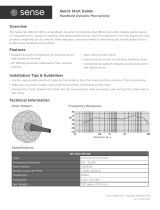 Sense SE-300-HM-SW Quick start guide
Sense SE-300-HM-SW Quick start guide
-
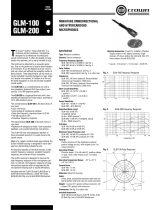 Crown Audio GLM-200 User manual
Crown Audio GLM-200 User manual
-
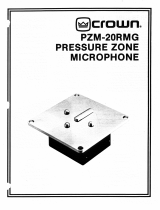 Crown Audio PZM-20RMG User manual
Crown Audio PZM-20RMG User manual
-
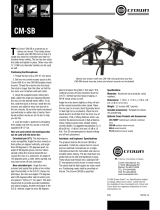 Crown Audio CM-SB User manual
Crown Audio CM-SB User manual
-
Superlux PRA628MKII User guide
-
 Chameleon Labs TS-1 MKII Owner's manual
Chameleon Labs TS-1 MKII Owner's manual
-
Optimus EM-410 User manual
-
AKG PZM11 LL Quick start guide
-
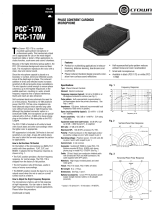 Crown Audio PCC-170 User manual
Crown Audio PCC-170 User manual














